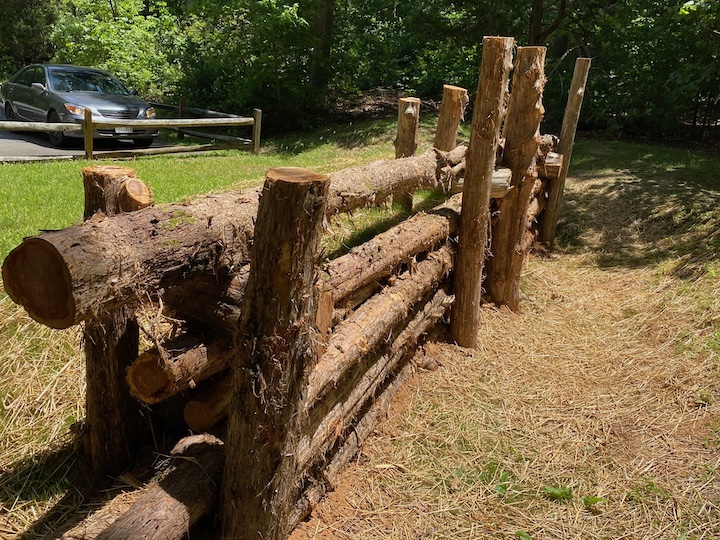Reconstructed Works along Lee’s Last Line
One of my favorite interpretive spots on the Spotsylvania battlefield sits at the end of Anderson Drive. It’s off the beaten path for most visitors because it’s at a dead end, and the park’s driving tour skips it over. For that reason, the far spur of Anderson Drive is a popular parking spot for dog walkers and joggers, but it doesn’t get a lot of history visitors.
While earthworks crisscross the battlefield, it’s hard to envision exactly what they looked like because 160 years of erosion, insects, and elements have degenerated them into long humps of dirt. However, thanks to the excellent work of Boy Scout Ethan Coffin of Stafford, Virginia, Spotsylvania National Battlefield offers an opportunity for people to get a better idea. As his Eagle Scout Project last year, Ethan rebuilt a set of reconstructed earthworks so visitors can see for themselves what earthworks once looked like.
Ethan’s reconstructed works fill in a gap at the edge of what’s now known as Lee’s Last Line. Once upon a time, the park road went through that area, cutting through Lee’s former position and intersecting with the nearby Brock Road. Too many people used Anderson Drive as a bypass around the village of Spotsylvania Court House, though, making for hazardous traffic conditions for anyone enjoying the battlefield. Years ago, the park closed off the road by removing the intersection at Brock Road and turning Anderson Drive into a dead end.
Where Anderson Drive had once passed through the earthworks, the park filled in the gap of Lee’s Last Line created by the road. It did so by reconstructing a set of earthworks. A visitor could stand in the ditch behind the works and suddenly see how formidable Civil War field fortifications were once upon a time. Accompanying signage provided an explanation and additional illustration.
Even better, a visitor could now stand in that spot and see where the western arc of the Mule Shoe Salient originally stretched to the north AND see where Lee sealed off the base of the Salient with the construction of his last line on May 12–13, 1864, in response to the collapse of the Mule Shoe. That last line later a gap in it for Anderson Drive to pass through; the reconstructed earthworks filled that gap and restored the landscape to its wartime appearance.
That set of reconstructed earthworks became bug-eaten and weather-worn over the last two decades. They looked a bit shaggy and run-down.
So I want to give a shout-out to Ethan for his work in restoring the recreated earthworks. They look fantastic—and they serve as an apt reminder of just how formidable the fortifications once were. I always take my own guests down there so they can see for themselves, and I highly recommend it as a stop for any battlefield visitor. Ethan’s work stands as a tangible reminder of what Confederates built and Federals faced.
Thanks, Ethan!
(Long-time battlefield visitors might also remember a set of reconstructed earthworks built as a reserve line behind the Bloody Angle. Those works have been “decommissioned” for years and, while still there, have been allowed to return to nature.)


Well done, Ethan!
Thanks Ethan for your Eagle project tat will help visitors and thanks Chris for bringing this story to our attention!
Wonderful job! Good choice of cedar, too. Those should last quite a while.
That’s an interesting spot – has it been dug for artifacts to any large extent?
This made me smile. I looked up a picture of teenage Neil from 2006 standing next to those reconstructed works. Happy to hear they are going to be there for future generations to see.